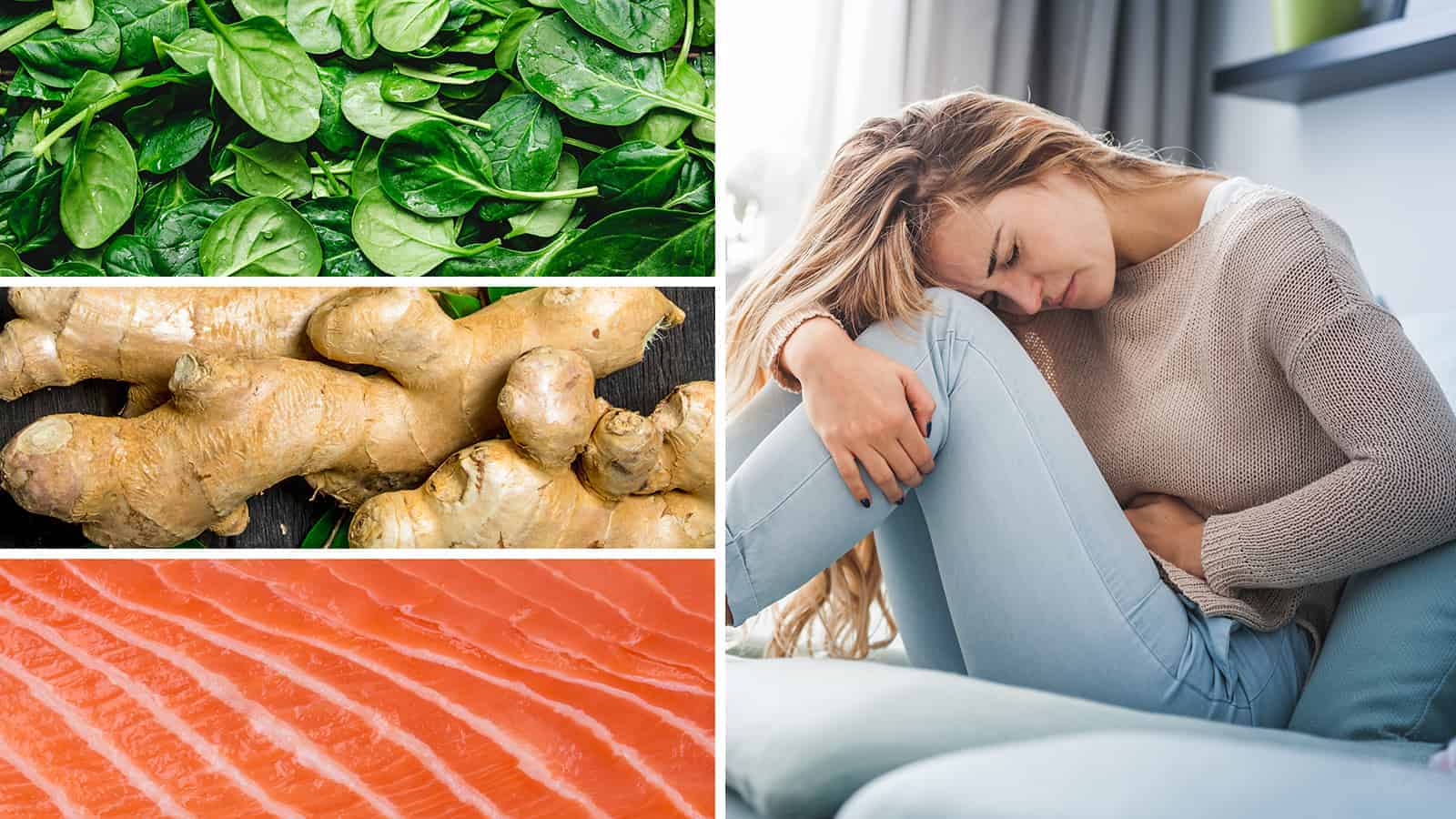(Editors Note: Updated to include fact-based references regarding the anti-inflammatory properties of Ginger)
Having a period is no fun, and it’s during these times of menstruation where hormones are at all-time highs and moods at their lowest.
Some women lay with the heating pad to soothe their cramps, while others lock themselves away during a period from the horrible mood swings.
Being the bearer of life comes with significant responsibilities. During the time of the month, women can experience fatigue, nausea, mood swings, headaches, abdominal cramping, bloating, diarrhea, and a general sick feeling. This doesn’t account for those ladies who have issues like polycystic ovary syndrome that make their cycles heavy or absent.
If there was a way to lessen the symptoms you feel by the things you eat and drink during your pregnancy, would you do it? What if having an apple each day really does keep the doctor away?
Twelve Foods That Can Help During A Period
Thankfully, there are a few things that you can eat and drink during your time of the month to make your periods easier on you. The good news is that most of these things you can find in your cabinet already, so there’s no need to spend a bunch of money on stuff. Here are the ten best things to add to your diet during your period.
 1. Ginger
1. Ginger
Ginger is a spice that has been used for all types of pain, as it’s effective. When you have bloating and cramping associated with your period, you should make a cup of ginger tea. The powerful anti-inflammatory effects of ginger can help you.
The Journal of Maternal-Fetal & Neonatal Medicine referenced a study done on ginger with nausea on expectant mothers. Not only did they find that it helped with both nausea and vomiting, but they found that it was a safe and inexpensive option. The key is to make sure that you don’t take more than four grams in one day, as it can cause stomach upset.
2. Water-Rich Fruits
It’s essential to stay well hydrated during your time of the month. Eating fruits that have a substantial amount of water in them can help. Additionally, the sweet nectar from fruits can help you to keep those sugar cravings at bay.
Some women crave sugar when they’re on their periods. This can cause your glucose levels to spike and crash, which makes you feel horrible. Staying hydrated and controlling those cravings will make your period more manageable.
3. Turmeric
Turmeric is getting a lot of hype these days as one of the spices that can fix just about anything. It has anti-inflammatory properties that can help during your period. You can add this spice to your foods, take a supplement, or mix it into a tea.
There is a great deal of medical research that backs up the claims that this spice is a powerful weapon against pain and bloating due to the anti-inflammatory properties.
4. Flaxseed Oil
Did you know that flaxseed oil has tons of omega-3 fatty acids in it? You need about 1,600 milligrams each day to fight free radicals, and this provides more than 7,100 milligrams in 15 milliliters. If you fight constipation during a period, then this natural oil can help to relieve that issue.
5. Fish
Fish, especially the cold-water varieties like salmon, is full of omega-3 fatty acids. Not only is it low in calories and full of protein, but it’s full of iron. When you’re menstruating, iron levels can fluctuate, but fish can help you maintain a healthy concentration.
Did you know that eating fish can be just as powerful as taking ibuprofen? A study was referenced by the International Journal of Gynecology and Obstetrics. They found that women who ate fish had fewer mood swings, depression and overall felt better during their period.
6. Kombucha
Kombucha is a tart, fermented tea that is packed full of yeast-fighting properties. You must be careful when buying these in the supermarket as many manufacturing companies add tons of sugar. You can easily make this tea from home with a bit of know-how.
Those who don’t want to consume dairy products like yogurt for yeast-fighting can turn to this magical elixir. It’s full of probiotics, antioxidants and has been known to kill harmful bacteria within the body. During a period, you need all the bacteria protection you can get.
7. Quinoa
Quinoa is a popular grain that is much healthier for you than rice. It has a nutrient profile that no female should ignore. Since you lose iron on your period, it has plenty of iron that can help.
Additionally, this grain has protein and magnesium, which will help with your moods and your cravings. Many people don’t realize that this is a gluten-free grain, so if you have a condition like celiac disease, it won’t aggravate it. Plus, people with diabetes love that it has a low glycemic index, which means it won’t cause sugar spikes or you to feel a crash after eating it.
8. Dark Chocolate
Dark chocolate and milk chocolate are not created equal. Dark chocolate has less sugar and some benefits that you cannot ignore, especially during your time of the month. Since this bar is full of magnesium, it can help to reduce the symptoms of premenstrual syndrome, according to a study referenced by The National Institute of Health.
 9. Chicken
9. Chicken
Chicken is a low-fat meat full of protein, and it’s another excellent source of iron. Having enough protein in your diet will help you stay full, improving your overall health. Women need all the help they can get curbing cravings when they have a cycle.
10. Leafy Green Vegetables
Since you’re losing blood during your period, it’s not uncommon for your iron levels to drop. A loss of iron can cause you to feel tired and lethargic. Thankfully, eating leafy greens like kale and spinach can help to increase your iron levels.
Another benefit that comes from spinach is the high levels of magnesium. Magnesium can help with mood swings and put you in a better frame of mind.
11. Lentils and Beans
Have you ever heard the jingle that says, “Beans, beans good for your heart?” Well, it appears that your heart isn’t the only thing beans are good for. Their high iron levels make them an excellent choice when your levels dip too low during a period.
They also have so much protein that many people see them as a good meal replacement option. Plus, don’t forget they are low in calories and rich in vitamins.
12. Nuts
Nuts are fantastic to eat as a snack. They have a high protein level in them, and they are full of magnesium and other vitamins. Did you know that eating almonds can help with headaches?
Additionally, nuts are full of omega-3 fatty acids so that they can fight free radicals with ease. If eating a handful of nuts isn’t your thing, then you can try several of the nut butter varieties on the market. Just make sure you get one that is all-natural and has little to no sugar.
Four Foods to Avoid During a Period
You cannot mention the things that you can eat without saying the ones that you should avoid. First, you need to watch your salt intake, as it can increase bloating. Plus, salt isn’t good for you anyway.
- Sugar: You need to monitor your sugar intake. Giving in to those intense cravings can cause your glucose levels to spike and crash, which will make you feel horrible. Sugar tastes terrific, but you can get your sweet fix from delicious fruits.
- Caffeine: Caffeine is another product that doesn’t do good things to your body. It can cause digestive issues, bloating, and headaches. If you’re accustomed to consuming coffee and soft drinks each day, you need to reduce, not cut it out during your cycle. You can also experience headaches by going without it too.
- Alcoholic Beverages: Alcohol is another thing that you should avoid. It can cause you to be dehydrated, which will lead to issues with your digestive system and cause bloating. Plus, alcohol can make your headaches much worse, and you certainly don’t want that on top of your period.
- Too Much Spice: Lastly, you need to avoid spicy foods. While you may love a good jalapeno or ghost pepper, you don’t want anything that will further irritate your stomach and cause diarrhea. This is certainly not the time to be experimenting if your body is not already accustomed to eating them.
Final Thoughts on Foods to Help During A Period
Having a period is a difficult time for many females. Some seem to have a three to four-day cycle and breeze through it, while others suffer for as long as seven or eight days. While the foods you eat can’t shorten the number of days you menstruate, it can make the symptoms easier to manage during a period.


















